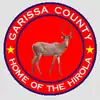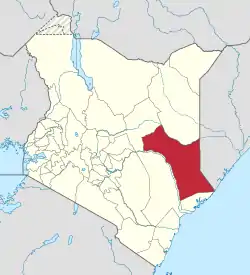Garissa County
Garissa County (Somali: Gobolka Gaarisa) is an administrative County in the former North Eastern Province of Kenya. Its capital and largest urban area is Garissa. The county had a population of 841,353 at the 2019 Census, and a land area of about 44,753 km2 (17,279 sq mi).[1] As of 31 August 2016, Garissa County had more than 260,000 Somali refugees in refugee camps at Dadaab, which is located in Garissa County.[2]
Garissa County
Gobolka Gaarisa | |
|---|---|
 Flag  Coat of arms | |
 Location in Kenya | |
| Coordinates: 0°27′25″S 39°39′30″E | |
| Country | |
| Formed | 4 March 2013 |
| Capital | Garissa |
| Government | |
| • Governor | Ali Bunow Korane (Jubilee) |
| • Deputy Governor | Abdi Dagane Muhumed (Jubilee) |
| • Senator | Yusuf Haji (Jubilee) |
| • Women Representative | Anab Mohamed Gure (Jubilee) |
| Area | |
| • Total | 44,753 km2 (17,279 sq mi) |
| Elevation | 1,138 m (3,734 ft) |
| Population (2019) | |
| • Total | 841,353 |
| • Density | 19/km2 (49/sq mi) |
| Time zone | UTC+3 (EAT) |
| Website | garissa.go.ke |
Demographics
Garissa county has a total population of 841,353 persons of which 458,975 are males, 382,344 females and 34 intersex person. There is a total of 141,394 household with an average size of 5.9 persons per house hold. It has a population density of 19 persons per square kilometre.[3]
Garissa County is mostly inhabited by ethnic Somalis.
| Year | Pop. | ±% |
|---|---|---|
| 1979 | 128,867 | — |
| 1989 | 124,835 | −3.1% |
| 1999 | 392,510 | +214.4% |
| 2009 | 623,060 | +58.7% |
| 2019 | 841,353 | +35.0% |
| source:[4] | ||
Distribution of Population, Land Area and Population Density by County
| Sub County | Area (km2) | Population 2019 Census[1] |
Popn. density |
|---|---|---|---|
| Balambala | 3,684 | 32,257 | 8.8 |
| Dadaab | 6,415 | 185,252 | 28.9 |
| Fafi | 15,050 | 134,030 | 8.9 |
| Garissa | 3,318 | 163,914 | 49.4 |
| Hulugho | 7,737 | 133,984 | 17.3 |
| Ijara | 2,453 | 141,591 | 57.7 |
| Lagdera | 6,096 | 50,315 | 8.3 |
| Totals | 44,753 | 841,353 | 18.8 |
Source[1]
Administrative and Political Units
Administrative Units
There are seven counties with 30 county assembly wards.[5] There are 22 divisions sud-divided into 96 locations and 142 sub-locations.[6]
It has six constituencies:
Political Leadership
Ali Bunow Korane is the second governor[7] for Garissa county and is deputised by Abdi Dagane Muhumed and assumed office in 2017.[8] Mohamed Yusuf Hajj has been the senator since 2013 he was the first to be elected as senator.[9] Anab Mohamed Gure assumed office in 2017 as the second elected women representative on a Jubilee Party ticket.[10]
County executives
- Hon. Abdi Muhumed Ali - County Secretary
- Hon. Habon A. Maalim - Energy, Environment and Tourism
- Hon. Ahmednadhir Omar - Health, Water and Sanitation
- Hon. Roble Nuno - Finance and Economic planning
- Hon. Habiba Nasib - Education, Youth, Polytechnics and Sports
- Hon. Adow Kalil Jubat - Commerce and Cooperatives Development
- Hon. Mohamed Abdi Shalle - Land, Housing Development and Public Works
- Hon. Issa Yarrow Kahin - Agriculture, Livestock and Fisheries
- Hon. Zeinab Abdi Digale - Children affairs, Social Welfare and Youth
- Hon. Issa Dubow Oyow - Water and Irrigation
- Hon. Abdi Omar - Transport and Infrastructure
County Assembly
According to the new Constitution that was enacted in 2010,Garissa County has an assembly whose members are elected from single member constituencies known as wards. There are also nominated members to ensure two-thirds gender rule is followed. There are six nominated members to represent marginalised groups (persons with disabilities, and the youth) and a speaker who will be an ex-official member of the assembly. A County Assembly member is elected for a term of five years. The Speaker is elected by the assembly members from among people who are not members of the Assembly. The Speaker presides over all sittings of the assembly and in his absence is deputised a deputy speaker who is elected from members within the assembly. The County assembly exercises an oversight over the County Government and makes laws that are necessary to ensure the smooth performance of the county government.
Education
The county has 347 ECD centres, 224 primary schools, 41 secondary schools, 2 teachers training colleges and 2 public universities.
39.7 percent of the population can read and write and 57.9 cannot read and write. There is and an average of 8.2 percent literacy level and 74percent are illiterate.[11]
| Category | No of Public | No of Private | Total |
|---|---|---|---|
| ECD | 210 | 137 | 347 |
| Primary School | 173 | 51 | 224 |
| Secondary School | 25 | 16 | 41 |
| Youth Polytechnic | 2 | 0 | 2 |
| Teachers Training Colleges | 2 | 0 | 2 |
| Technical Institutions | 1 | 0 | 1 |
| Universities | 1 | 2 | 3 |
Source [12]
Health
There are a total of 111 health facilities distributes across the county, one level 5, 14 other hospitals, 29 health centres and 67 dispensaries.[13]
| Diseases | Percentage |
|---|---|
| Upper Respiratory Tract Infections | 30.9 |
| Urinary Tract Infection | 15.2 |
| Diarrhoeal diseases | 9.5 |
| Diseases of the skin | 7.4 |
| Pneumonia | 6.7 |
Source [11]
HIV/ADS is at the 1 percentage as compared to the national prevalent rate of 5.6 percentage.[13]
Transport and Communication
A total of 2,700.6 km is classified as road network coverage comprising 1,637.84 km under county government and 1,062.76 km under national government. Of the total road network 420 km is covered by gravelled surface, 2,245.1 km earth surface and .5 km of bitumen surface.[11]
There are 6 postal services with 2,600 installed letter boxes, 2,496 rented letter boxes 104 vacant letter boxes.[14]
Trade and Commerce
The main crops grown are maize, greengrams, sorghum, rice, cowpeas, bananas, mangoes, pawpaw, water melon, tomatoes, capsicum and onions. Farmers have an average size of 1.5 hectares for small scale and 20 hectares for large scale. cattle (boran), goats (galla), sheep (black headed Persian) and camel (dromedary one humped) are kept as the main livestock for producing key products of meat, milk, hides and skins.[14][13]
Services and Urbanisation
| County | Status for the County (Percent) | ||||||||
|---|---|---|---|---|---|---|---|---|---|
| Urbanisation | 23.5 | ||||||||
| Literacy | 52.4 | ||||||||
| Attending School (15-18 Yrs) | 43.9 | ||||||||
| Paved Roads | 0 | ||||||||
| Good Roads | 54.1 | ||||||||
| Electricity Access | 11.6 | ||||||||
| Poverty Rate | 49.2 | ||||||||
|
Stats for the County | |||||||||
Source: USAid Kenya
See also
References
- 2019 Kenya Population and Housing Census, Volume 2.
- "Total Refugees from Somalia". Operational Portal: Refugee Situations. UNHCR. Retrieved 7 September 2016.
- Munene, Evans (4 November 2019). "2019 Kenya Population and Housing Census Results". Kenya National Bureau of Statistics. Retrieved 27 May 2020.
- Kenya: Administrative Division population statistics
- IEBC. "The Report of the Interim Independent Boundaries Review Commission (IIBRC): Delimitation of Constituencies and Recommendations on Local Authority Electoral Units and Administrative Boundaries for Districts and Other Units" (PDF). Retrieved 27 May 2020.
- interior_admin. "Ministry of Interior and Coordination of National Government". interior.go.ke. Retrieved 27 May 2020.
- "Members of the County Executive". Garissa County Government. Archived from the original on 19 March 2015. Retrieved 25 November 2014.
- "Governors & Deputy Governors". cog.go.ke. Retrieved 27 May 2020.
- "Members of the Senate | The Kenyan Parliament Website". www.parliament.go.ke. Retrieved 27 May 2020.
- "Women Representatives | KEWOPA KENYA". Retrieved 27 May 2020.
- Garissa County. "Second Garissa County Integrated Development Plan CIDP 2018-2022". Retrieved 27 May 2020.
- "Ministry of Education". www.education.go.ke. Retrieved 27 May 2020.
- Garissa County (2019). Second Garissa County Integrated Development Plan CIDP 2018-2022. Garissa County Government. p. 28.
- Garissa County (2015). County Statistical Abstract Garissa County 2015. Kenya National Bureau of Statistics. p. 16.